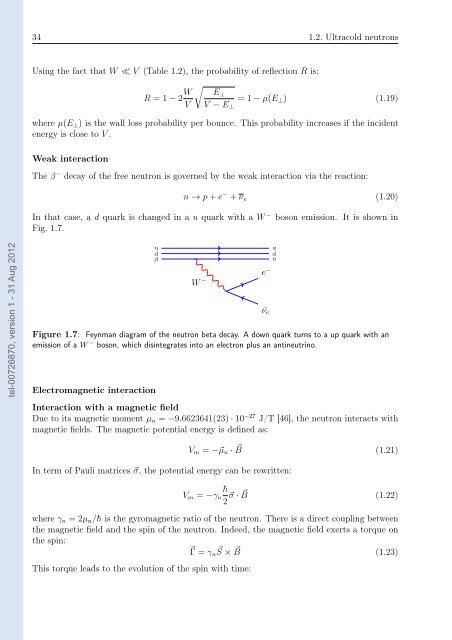Développement et optimisation d'un système de polarisation de ...
Développement et optimisation d'un système de polarisation de ...
Développement et optimisation d'un système de polarisation de ...
You also want an ePaper? Increase the reach of your titles
YUMPU automatically turns print PDFs into web optimized ePapers that Google loves.
tel-00726870, version 1 - 31 Aug 2012<br />
34 1.2. Ultracold neutrons<br />
Using the fact that W ≪ V (Table 1.2), the probability of reflection R is:<br />
R = 1 − 2 W<br />
V<br />
E⊥<br />
V − E⊥<br />
= 1 − µ(E⊥) (1.19)<br />
where µ(E⊥) is the wall loss probability per bounce. This probability increases if the inci<strong>de</strong>nt<br />
energy is close to V .<br />
Weak interaction<br />
The β − <strong>de</strong>cay of the free neutron is governed by the weak interaction via the reaction:<br />
n → p + e − + νe<br />
(1.20)<br />
In that case, a d quark is changed in a u quark with a W − boson emission. It is shown in<br />
Fig. 1.7.<br />
u u<br />
d<br />
d<br />
d<br />
u<br />
W −<br />
Figure 1.7: Feynman diagram of the neutron b<strong>et</strong>a <strong>de</strong>cay. A down quark turns to a up quark with an<br />
emission of a W − boson, which disintegrates into an electron plus an antineutrino.<br />
Electromagn<strong>et</strong>ic interaction<br />
Interaction with a magn<strong>et</strong>ic field<br />
Due to its magn<strong>et</strong>ic moment µn = −9.6623641(23) · 10 −27 J/T [46], the neutron interacts with<br />
magn<strong>et</strong>ic fields. The magn<strong>et</strong>ic potential energy is <strong>de</strong>fined as:<br />
In term of Pauli matrices σ, the potential energy can be rewritten:<br />
e −<br />
¯νe<br />
Vm = −µn · B (1.21)<br />
¯h<br />
Vm = −γn<br />
2 σ · B (1.22)<br />
where γn = 2µn/¯h is the gyromagn<strong>et</strong>ic ratio of the neutron. There is a direct coupling b<strong>et</strong>ween<br />
the magn<strong>et</strong>ic field and the spin of the neutron. In<strong>de</strong>ed, the magn<strong>et</strong>ic field exerts a torque on<br />
the spin:<br />
Γ = γn S × B (1.23)<br />
This torque leads to the evolution of the spin with time:

















